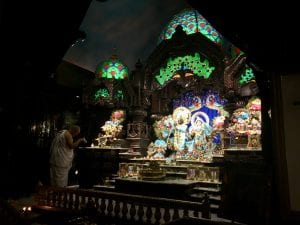When I think about India in general terms, fair or not, my mental impression is one that is overpowering from a sensory perspective. The class visit to the ISKCON temple in Dallas fit directly into this frame and was quite literally a foreign experience. Although once a church, the space was entirely unfamiliar in context of Western traditions, though somehow the act of removing our shoes at the door seemed to remove at least one degree of separation for us as an outgroup. Walking into the room, I almost stumbled over a woman bent prostrate a few feet from the door and, a few seconds later, was startled by another woman spraying some questionable substance on me. Draped in what would be a passable costume for a toga party, the priest was incessantly chiming a bell behind the barricade separating the deities from the public space.
Despite his clear status as a senior, our guide had the sincerity of a child paired with the enthusiasm of a new convert. He talked about Krishna Consciousness, and its goal of controlling the mind by replacing ignorance with knowledge and focus—as he put it, “catching the mind between the tongue and the ear.” For followers of the movement, knowledge begins with an understanding that for the soul, there is neither birth nor death, and we are not our physical bodies. The mind is always wandering and lamenting, but when focused on the present, the mind is clear and it is possible to recognize the nature of your eternal soul and realize your spiritual identity. Perhaps one of the reasons why the movement initially pulled many people from American counterculture is, as Prabhupad says, “The only qualification required in this connection is to be a pure devotee of the Lord. It does not matter what one is or where one is situated” (Hopkins 191). In this sense, as our guide and the article both confirmed, ISKCON theology bears a striking resemblance, from the surface, to Christianity.
Although the movement was initially dominated by counterculture, it gradually transitioned back to a largely Indian population. As Hopkins write, “Indian immigrants were drawn to ISKCON’s temples and activities as a way to maintain their religious identity as they adjusted to a new culture, and they in turn added an established multi-generational Hindu householder community to ISKCON’s membership” (Hopkins 181). In the structure of the temple itself, it’s possible to point to elements of both Western and Eastern culture. In contrast to a traditional Western church (which is what the space used to be), there is no seating arrangement; in fact, as a large, empty space for dancing, there is no orientation to the room at all, save the idols, which are covered by a curtain. The benches lining the perimeter of the room are solely a Western convention. The temple itself is a converted church recreation room—there used to be basketball goals flanking the room—now lined with demi-gods and paintings of Krishna. The transition itself seems representative of the contour of the movement as a whole.
—
Hopkins, Thomas J. “ISKCON’s Search for Self-Identity: Reflections by a Historian of Religions.” In The Hare Krishna Movement: Forty Years of Chant and Change. Edited by Graham Dwyer and Richard J. Cole, 171-192. New York: I.B.Tauris & Co. Ltd., 2007.

